If you wish to live and thrive...
On attending all three Tombio spider courses: if you wish to live and thrive…
I’ve always lived in old houses where there were plenty of spiders to be found inside and outside, and I’ve always liked them. My grandmother taught me the rhyme. "If you wish to live and thrive, let a spider run alive" when I was very young, so I grew up viewing them as rather a force for good. She never explained quite why they are so beneficent – I doubt she knew - but probably their ability to catch flies and the therapeutic qualities of their webs have something to do with it.
Recently I’ve grown interested in their ecology and behaviour, and in trying to watch them more systematically and learn about the different species living around where I live. I’ve attended a couple of very good invertebrate courses – an FSC course on dragonflies (the field session included a visit to the excellent Bog tearoom!), and a recent MMU course at the Gateway on moths. The dragonfly course focused on identifying specimens in the field, and the moth course on identification of live specimens. However, I’ve also been on an FSC invertebrate course where the focus was on catching and killing specimens for the purpose of identification. The room we were in quickly began to resemble a killing field, and I decided that that wasn’t for me. I’m aware that full identification often requires the examination of some specimens under a microscope, but aside from ethical and biodiversity issues, it is also much more difficult for a relative beginner such as myself to identify to species without first having some contextual information.
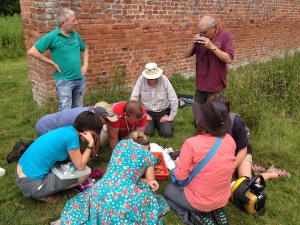
The FSC course that was run last May was called ‘Learn to Love Spiders’ and offered a ‘gentle introduction to the world of spiders and the art of telling one spider from another’. This seemed like my kind of course! Another positive feature of the course was that it was designed for people with a variety of backgrounds and interests, including people with a spider phobia. There weren’t any arachnophobes in this particular group, although there was someone who had suffered in the past, and one member of the group worked for a pest control company and had developed his interest through having to deal with other people’s spider phobias! Proceedings were conducted by Nigel Cane-Honeysett and Rich Burkmar, ably supported by Charlie Bell, and both the practical and the information-giving sessions were interesting, lively, and informative. There was good follow-up support too, with British Arachnological Society fact sheets about different spider species available for free, and a number of useful book recommendations.
We learnt about the evolutionary place of spiders, different spider orders, families and species, their physiology, the ways in which they sense the world, different types of web construction, and mating behaviour (being a male spider can be a dangerous occupation!). There were some intriguing details: female wolf spiders actively rear their spiderlings, and some female spiders that lose their egg sacs have been known to find an alternative load as compensation. This suggests an interesting level of sentience not commonly associated with invertebrates.
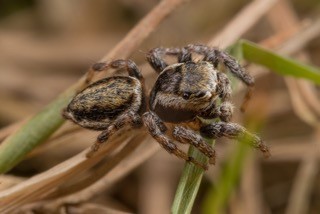 The day ended with an invitation from Nigel to join a ’Just Watch it’ observation and photography day at Whixall Moss, partly organised by the Shropshire Spider group, and since this was not far from where I live I decided to go along. The idea of just looking and observing appealed to me, and although I’m not much of a photographer, I took my phone along so as not to be left out! There was some serious photographic equipment being used by a few members of the group, but I have to say that the quality of the photographs sent around to everyone subsequently was outstanding. There was also a lot of identification and recording going on, and as they were a very helpful and encouraging bunch, I learnt a lot from their expertise – including what a long way I had to go. Their knowledge of the invertebrate and plant species that we encountered was as impressive as the photos! What is special about much invertebrate research, and indeed the whole biological recording enterprise is the regard paid to the work of amateurs; not having academic qualifications in a relevant field is not a disqualification for becoming involved.
The day ended with an invitation from Nigel to join a ’Just Watch it’ observation and photography day at Whixall Moss, partly organised by the Shropshire Spider group, and since this was not far from where I live I decided to go along. The idea of just looking and observing appealed to me, and although I’m not much of a photographer, I took my phone along so as not to be left out! There was some serious photographic equipment being used by a few members of the group, but I have to say that the quality of the photographs sent around to everyone subsequently was outstanding. There was also a lot of identification and recording going on, and as they were a very helpful and encouraging bunch, I learnt a lot from their expertise – including what a long way I had to go. Their knowledge of the invertebrate and plant species that we encountered was as impressive as the photos! What is special about much invertebrate research, and indeed the whole biological recording enterprise is the regard paid to the work of amateurs; not having academic qualifications in a relevant field is not a disqualification for becoming involved.
I didn’t want to stop there so booked a place on ‘Field Identification of Spiders and Harvestmen’ that was held in July and run by the same team. Again, an appealing blurb promised the identification of these animals in the field, with specimens being collected for closer examination, and returned at the end of the day. Some similar ground was covered as in the first course, but not in exactly the same way, and this was useful revision for me. The opening sessions included information about spider physiology, different web structures, and interesting spider species. Practical resources were introduced including the spi-pot, constructed from an unlikely combination of a rigid toothpaste tube, foam and cling film. This turned out to be an invaluable piece of kit that enables you to examine a motionless spider through the cling film with a hand lens without injuring it; other tricks of the trade included using a vibrating toothbrush on a web to inveigle the spider out of its hiding place.
In the afternoon we set off around the grounds of Bishops Wood to see what was there, collect live specimens, and try to identify them. The course leaders were very helpful throughout. We were given good guidance about using books and keys, and Nigel had produced a guide to families by habitat, which I found extremely useful then and subsequently. The final session of the day involved looking at what we had found on screen. The star of this show was a quite different kind of arachnid though – a very cute pseudoscorpion that everyone seemed quite enchanted by!
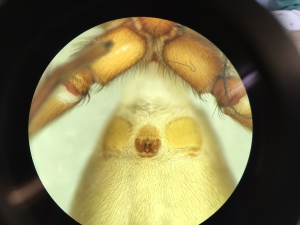 By this stage I more fully appreciated the need to examine some specimens under the microscope, so booked the third course in September. Happily the specimens were provided, so no immediate ethical dilemmas! From the previous courses I had already learned a lot about spider physiology, could distinguish gender, and recognise a few families so found I could identify a number of the specimens without too much difficulty. It was another interesting, rewarding and enjoyable day with again excellent help and support from the course tutors. They presented their own considerable knowledge and expertise as something we could all achieve, given time and application, rather than something beyond the reach of lesser mortals!
By this stage I more fully appreciated the need to examine some specimens under the microscope, so booked the third course in September. Happily the specimens were provided, so no immediate ethical dilemmas! From the previous courses I had already learned a lot about spider physiology, could distinguish gender, and recognise a few families so found I could identify a number of the specimens without too much difficulty. It was another interesting, rewarding and enjoyable day with again excellent help and support from the course tutors. They presented their own considerable knowledge and expertise as something we could all achieve, given time and application, rather than something beyond the reach of lesser mortals!
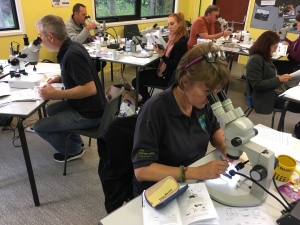 Throughout these courses, Nigel had been very persistent in encouraging us to join the British Arachnological Society, so at the end of this one I decided it was time to join. The material that the BAS sent to me included an extremely useful and informative handbook that has a section on keeping spiders in captivity. Early on in the chapter though, the writer suggests that even this is not always necessary, and that a number of species can be observed productively in their natural habitat. Looking and observing the use that spiders make of our house seemed a good way to follow up what the courses had started. The following are some of the observations made during a week in the summer. There are webs of various kinds in all the nooks and crannies around the exterior of the house and outbuildings, not all of which are in current occupation. A favourite place is the rotating washing line, with numerous occupied webs and threads continuously strung across and round it, in spite of the regular interruption of having washing hung over them.
Throughout these courses, Nigel had been very persistent in encouraging us to join the British Arachnological Society, so at the end of this one I decided it was time to join. The material that the BAS sent to me included an extremely useful and informative handbook that has a section on keeping spiders in captivity. Early on in the chapter though, the writer suggests that even this is not always necessary, and that a number of species can be observed productively in their natural habitat. Looking and observing the use that spiders make of our house seemed a good way to follow up what the courses had started. The following are some of the observations made during a week in the summer. There are webs of various kinds in all the nooks and crannies around the exterior of the house and outbuildings, not all of which are in current occupation. A favourite place is the rotating washing line, with numerous occupied webs and threads continuously strung across and round it, in spite of the regular interruption of having washing hung over them.
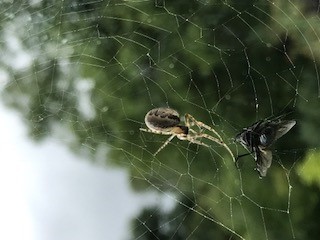 In the garden, on the edge of our pond I found a Pirata species with a large white egg sac, but given its interesting condition decided not to put it in the spi-pot to find out more. I managed to get a reasonable photo of a garden spider tucking into a large fly just outside the bathroom window. The inside of the house abounds with various Tegenaria species, especially the bathroom and sitting rooms, where they struggle across the carpet, frequently pausing for breath. One day I saw a quite different species on a kitchen window: smaller and lighter coloured than Tegenaria. It was there the next day and the following, not seeming to be doing very much. It didn’t have a web, but very early one morning I saw a series of threads stretched across the space from a kitchen unit to the table, so decided it might be a nocturnal spider. I used the spi-pot and a lens to get a closer look, and Nigel’s guide to reduce possibilities: definitely female and with a distinctive patterning on the carapace and legs. Best fit in terms of patterning, features, habitat and habits was Scytodes thoracica, but one guide indicated that this species is not generally found as far north as Shropshire, and is uncommon, so perhaps not! Further attempts at identification were completely thwarted when I accidentally walked into her threads early one morning and she disappeared, never to be seen again: there might sometimes be something to be said for captivity!
In the garden, on the edge of our pond I found a Pirata species with a large white egg sac, but given its interesting condition decided not to put it in the spi-pot to find out more. I managed to get a reasonable photo of a garden spider tucking into a large fly just outside the bathroom window. The inside of the house abounds with various Tegenaria species, especially the bathroom and sitting rooms, where they struggle across the carpet, frequently pausing for breath. One day I saw a quite different species on a kitchen window: smaller and lighter coloured than Tegenaria. It was there the next day and the following, not seeming to be doing very much. It didn’t have a web, but very early one morning I saw a series of threads stretched across the space from a kitchen unit to the table, so decided it might be a nocturnal spider. I used the spi-pot and a lens to get a closer look, and Nigel’s guide to reduce possibilities: definitely female and with a distinctive patterning on the carapace and legs. Best fit in terms of patterning, features, habitat and habits was Scytodes thoracica, but one guide indicated that this species is not generally found as far north as Shropshire, and is uncommon, so perhaps not! Further attempts at identification were completely thwarted when I accidentally walked into her threads early one morning and she disappeared, never to be seen again: there might sometimes be something to be said for captivity!
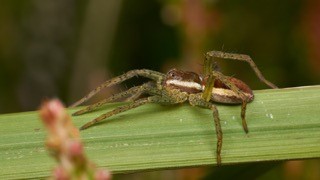 I want to get better at identification, but I also have a great interest in invertebrate cognition, so have been reading about that, what it might be, and how it can be researched. I’m a qualitative researcher by trade, so it is also interesting to consider the contribution such methods might make to research of this kind. The situation of invertebrates is currently so desperate that I want to make some kind of contribution, though I’m not yet sure what. I’m enormously grateful to Nigel, Rich, and Charlie though for giving me the confidence to think that this might be a possibility!
I want to get better at identification, but I also have a great interest in invertebrate cognition, so have been reading about that, what it might be, and how it can be researched. I’m a qualitative researcher by trade, so it is also interesting to consider the contribution such methods might make to research of this kind. The situation of invertebrates is currently so desperate that I want to make some kind of contribution, though I’m not yet sure what. I’m enormously grateful to Nigel, Rich, and Charlie though for giving me the confidence to think that this might be a possibility!
Lesley Lancaster, October 2017
- Anonymous's blog
- Log in or register to post comments



